
About UsThe Numismatic Bibliomania Society is a non-profit organization promoting numismatic literature. For more information please see our web site at coinbooks.org SubscriptionsThose wishing to become new E-Sylum subscribers (or wishing to Unsubscribe) can go to the following web page link MembershipThere is a membership application available on the web site Membership Application To join, print the application and return it with your check to the address printed on the application. Membership is only $15 to addresses in the U.S., $20 for First Class mail, and $25 elsewhere. For those without web access, write to: David M. Sundman, Secretary/TreasurerNumismatic Bibliomania
Society AsylumFor Asylum mailing address changes and other membership questions, contact David at this email address: dsundman@LittletonCoin.com SubmissionsTo submit items for publication in The E-Sylum, just Reply to this message, or write to the Editor at this address: whomren@coinlibrary.com
BUY THE BOOK BEFORE THE COINYou won't regret it! |
- WAYNE'S WORDS: THE E-SYLUM FEBRUARY 1, 2009
- CONTENTS OF THE ASYLUM VOLUME 26, NO. 4
- DAVID SKLOW-FINE NUMISMATIC BOOKS MAIL BID SALE #6 CLOSES FEBRUARY 7, 2009
- BRYCE BROWN'S NUMISMATIC LITERATURE FIXED PRICE LIST AVAILABLE
- NEW BOOK: THE AUTHORITATIVE REFERENCE ON COMMEMORATIVE COINS, 1892-1954
- NEW BOOK ON LINCOLN CENT MATTE PROOFS
- CHICAGO COIN COMPANY NUMISMATIC LIBRARY OPEN FOR VISITORS' USE
- HOW MONEY IS COINED: RARE NEW ORLEANS MINT PAMPHLET TO BE REPRINTED
- BOOK REVIEW: UNITED STATES PATTERN COINS 2009 10TH EDITION BY J. HEWITT JUDD
- NEW BOOK: COINS: QUESTIONS AND ANSWERS FIFTH EDITION BY CLIFFORD MISHLER
- AMERICA'S OLDEST FREE LIBRARY MAY CLOSE
- THE ROYAL COLLECTION OF HANNOVER MAY BE SOLD
- RESEARCHING A GUIDE BOOK OF PEACE DOLLARS
- MORE ON THE ARMAND-DELILLE RABBIT MEDAL
- ON THE NATURAL DRAW OF MONEY
- MORE ON THE SOCIETY OF BEARDED NUMISMATISTS
- DO E-SYLUM READERS DESERVE A MEDAL?
- HAS EARLY ARTWORK FOR THE MORGAN DOLLAR BEEN FOUND? OTHERS THINK NOT
- THE FIRST ENCAPSULATED U.S. COIN: 1840-O HALF DIME IN GLASS
- NUMISMATIC NEWSPAPERS AND THE U.S. POST OFFICE
- 2,000 YEAR OLD HOARD OF GOLD COINS FOUND
- HMS VICTORY WRECK FOUND IN BRITISH CHANNEL; WAS HAULING FOUR TONS OF GOLD COINS
- WHERE TO OBTAIN ZIMBABWE HYPERINFLATION BANKNOTES
- ANOTHER CONCORD REVOLUTION: A BUSINESS BANS THE CENT
- CONCORD CENT REVOLUTION ADVOCATES SUGGEST MAKING A LINCOLN STATUE OF THE COINS
- IS U.K. COIN GLUT AN UNINTENDED CONSEQUENCE OF A TAX CHANGE?
- OHIO CREDIT UNION PROMOTION GENERATES AN AVALANCHE OF COIN DEPOSITS
- OBAMA HUCKSTERS STICKING SUCKERS WITH STICKERS
- GHOST WHISPERER HELPS DEAD NUMISMATIST FIND PEACE
- FEATURED WEB PAGE: IRISH MINING TOKENS
WAYNE'S WORDS: THE E-SYLUM FEBRUARY 1, 2009
 Among our recent subscribers are Gene Belair, Joseph Morris, and Joseph Fuller Jr., courtesy of John and Nancy Wilson, Dan Altshuler, courtesy of Dick Johnson, Jeff Erickson, and Susan Headley. Welcome aboard! We now have 1,230 subscribers.
Among our recent subscribers are Gene Belair, Joseph Morris, and Joseph Fuller Jr., courtesy of John and Nancy Wilson, Dan Altshuler, courtesy of Dick Johnson, Jeff Erickson, and Susan Headley. Welcome aboard! We now have 1,230 subscribers. This week we open with an update from Editor David Yoon on the latest issue of our print journal, The Asylum. Next, we hear from numismatic literature dealers David Sklow and Bryce Brown. New books profiled this week cover topics including U.S. commemorative coins, matte proof Lincoln cents, and a reprint of a rare pamphlet on the New Orleans Mint.
We also have more information on topics discussed earlier, such as the dead rabbit medal and the Society of Bearded Numismatists. To learn about the earliest U.S. encapsulated coin, read on. Have a great week, everyone!
Wayne Homren
Numismatic Bibliomania Society
CONTENTS OF THE ASYLUM VOLUME 26, NO. 4
David Yoon, Editor of our print journal The E-Sylum reports that the latest issue (vol. 26 no. 4) was sent to the printers a couple of weeks ago and should be arriving in NBS members' mailboxes shortly. David forward the contents of the issue as follows:- P. Scott Rubin - Overview of Wayte Raymond's Standard Catalogue of United States Coins
- Joel J. Orosz - The Curious Tale of the Encheiridion ad Illustrandam Interpretationem Abbreviationum in Graecis et Latinis Auctoribus: The Most Obscure Great Rarity in US Numismatic Literature
- W. David Perkins - The Lettered Edge: Newsletter of the Bust Dollar Club
- Elizabeth Hahn - The ANS Library: Up and Running
- Robert D. Leonard Jr. - Comment on Augsburger's "A Bibliographic Guide to American Content in the National Numismatic Collection"
DAVID SKLOW-FINE NUMISMATIC BOOKS MAIL BID SALE #6 CLOSES FEBRUARY 7, 2009
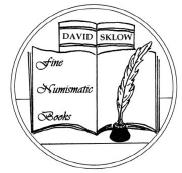 David Sklow would like to take this opportunity to gently remind readers that his current mail bid sale of "Fine Numismatic Literature” closes February 7th. Highlights include:
David Sklow would like to take this opportunity to gently remind readers that his current mail bid sale of "Fine Numismatic Literature” closes February 7th. Highlights include: - A wonderful library of over 125 works on Ancient Roman and Greek Numismatics;
- Du Choul, Guillaume. VETERUM ROMANORUM RELIGIO, CASTRAMETATIO, DISCIPLINA MILITARIS UT BALNEAE: EX ANTIQUIS NUMISMATIBUS & LAPIDIBUS DEMONFTRATA. Amsterdam, 1685
- Easton, E. {Publisher}. ANTIQUITATES SARISBURIENSES. London, 1771
- Hendriks, Frederick. DECIMAL COINAGE: A PLAN FOR ITS IMMEDIATE EXTENSION IN ENGLAND, IN CONNECTION WITH THE INTERNATIONAL COINAGE OF FRANCE AND OTHER COUNTRIES. Bucklers bury, England. 1866
- Breen, Walter and Gillio, Ronald J. CALIFORNIA PIONEER FRACTIONAL GOLD – “ADVANCE COPY”. Wolfeboro, N.H. 2003
- Edwards, Jonathan, M.D. CATALOGUE OF THE GREEK AND ROMAN COINS IN THE NUMISMATIC COLLECTION OF YALE COLLEGE. New Haven, 1880. iv-vi, 236pp. 8vo, original brown decorative cloth covers, gilt spine
- Memorabilia of the great numismatic dealer B. Max Mehl, including a long run of his auction catalogs, Mehl's Numismatic Monthly, advertising items of every description, Mehl family photographs, letters, Mehl's Coin Circular, Mehl's Coin Chronicle
- Very Rare "Sponsors Edition" of The National Bank note Issues of 1929-1935 copy #3 of 25
- A run of bound New Hampshire Bank reports
- Several bound historical works concerning the 1892-1893 Columbian Exposition
- Kroh, Dennis J. ANCIENT COIN REFERENCE REVIEWS. [SPECIAL HARDBOUND NUMBERED EDITION # 1of 20]
- Morris, Robert. THE TWELVE CAESARS: (JULIUS TO DOMITIAN) ILLUSTRATED BY READINGS OF TWO HUNDRED AND SEVENTEEN OF THEIR – COINS AND MEDALS. La Grange, KY., 1877
- Mehl, B{enjamin} Max. 1907 WEDDING PHOTO OF B. MAX AND ETHEL.{Fort Worth, TX.}. 14.5 x 22 cm. black and white, professional portrait of B. Max seated, and his wife Ethel, standing at his side
- Raymond, Wayte and Macallister, J{ames}.G.{cataloguers}. THE NUMISMATIC AUCTION CATALOGUES OF J.C. MORGENTHAU & CO. New York, N.Y. 1932-1945. Adams Sale Numbers One through Fifty-three complete. The large format (4to) catalogues are bound uniformly in two quarto volumes; dark brown grained half cowhide, five raised spine bands, maroon calf spine labels, gilt, marbled paper boards: the small format (8vo) catalogues are housed in two quarto solander book boxes, matching identically the two other volumes; all original printed card covers are present; all quarto sales with original prices realized; many octavo sales with original prices realized and several hand priced
- Mickley, Jos. J. DATES OF UNITED STATES COINS AND THEIR DEGREES OF RARITY. Philadelphia, PA. 1858. 4pp. 8vo.
- Grueber, H{erbert}.A{ppold}., F.S.A. A FIND OF ANGLO-SAXON COINS. London, 1894, 48pp. 2 autotype plates, {also} THE BALCOMBE FIND. London, 1898, 65pp. 4 autotype plates, 8vo, half leather with marbled boards, four raised bands on spine, gilt spine
- Dye, John S. BANKING HOUSE OF JOHN S. DYE [DELINEATOR LETTER].New York. 1854, 8vo, 27 x 21cm;
- Frossard, Ed{ouard}. NUMISMA. [DELUXE EDITION]. Minneapolis, MN. And Rocky River, OH. 1983 reprint of the 1877-1891 original, ten volumes complete. Special limited Edition copy # 4 of 4 produced. Half leather with marbled boards, gilt spine, marbled pastedowns and endpapers. A very special limited numbered edition of 4, of which this is number 4. Ex Kenneth Lowe Library sale by The Money Tree sale 32 lot 146
- United States Government. {Secretary of the Treasury}. LETTERFROM THE SECRETARY OF THE TREASURY TRANSMITTING SUNDRY STATEMENS REATIVE {SIC} TO THE OPERATIONS OF THE MINT OF THE UNITED STATES: FEBRUARY 28, 1817. READ AND ORDERED TO LIE UPON THE TABLE. Washington: 1817, 10pp. 1 foldout, folio 33.5 x 21cm.
- and something for everyone!
For more information on the sale please see my web site: Finenumismaticbooks.com .
Bids will be accepted by:
USPS Mail @ David Sklow-Fine Numismatic Books, P.O. Box 6321, Colorado Springs, CO. 80934
Email @ numismaticbooks@aol.com
Telephone @ (719)-302-5686
Fax @ (719)-302-4933
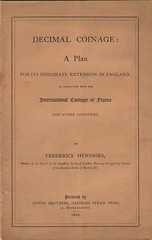 Lot 51: Hendriks, Frederick. DECIMAL COINAGE: A PLAN FOR ITS IMMEDIATE EXTENSION IN ENGLAND, IN CONNECTION WITH THE INTERNATIONAL COINAGE OF FRANCE AND OTHER COUNTRIES. Bucklersbury, England. 1866.
Lot 51: Hendriks, Frederick. DECIMAL COINAGE: A PLAN FOR ITS IMMEDIATE EXTENSION IN ENGLAND, IN CONNECTION WITH THE INTERNATIONAL COINAGE OF FRANCE AND OTHER COUNTRIES. Bucklersbury, England. 1866.In this work, it is proposed to give a brief, but, it is hoped, sufficiently succinct, outline of an enquiry into some interesting questions of the day, relating to:- I- International Coinage, II- The present position of the Decimal system. Includes a brief memorandum of the Parliamentary and public history of the progress of decimalization of the pound sterling 1824-1859.
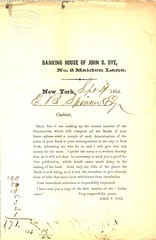 Lot 254: Dye, John S. BANKING HOUSE OF JOHN S. DYE [DELINEATOR LETTER]. New York. 1854, 8vo, 27 x 21cm. folded. Banking House of John S. Dye, No. 2 Maiden Lane – New York, Sept 4, 1854. (signed) E.B. Spinner Esq. Cashier, Dear Sir- I am making up the second number of the Delineator, which will comprise all the Banks of your State-………very respectfully, yours, John S. Dye. On the back side is written: John S. Dye, Esq. Sept 4th 1854, answered Sept 14th 1854 in Dye‘s hand. Also there is the oval blind stamp of John S. Dye, Banker, New York at top left corner.
Lot 254: Dye, John S. BANKING HOUSE OF JOHN S. DYE [DELINEATOR LETTER]. New York. 1854, 8vo, 27 x 21cm. folded. Banking House of John S. Dye, No. 2 Maiden Lane – New York, Sept 4, 1854. (signed) E.B. Spinner Esq. Cashier, Dear Sir- I am making up the second number of the Delineator, which will comprise all the Banks of your State-………very respectfully, yours, John S. Dye. On the back side is written: John S. Dye, Esq. Sept 4th 1854, answered Sept 14th 1854 in Dye‘s hand. Also there is the oval blind stamp of John S. Dye, Banker, New York at top left corner. BRYCE BROWN'S NUMISMATIC LITERATURE FIXED PRICE LIST AVAILABLE
Bryce Brown of Avon, CT writes:NEW BOOK: THE AUTHORITATIVE REFERENCE ON COMMEMORATIVE COINS, 1892-1954
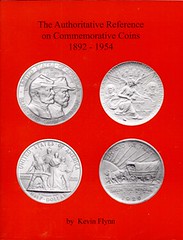 The Commemorative Coin book titled “The Authoritative Reference on Commemorative Coins, 1892-1954” by Kevin Flynn is now available. This book is being published by Kyle Vick, 1570 Holcomb Road, Suite 120, Roswell, GA, 30076, and is 360 pages, 8 ½ by 11, and contains hundreds of photographs. Retail is $39.95.
The Commemorative Coin book titled “The Authoritative Reference on Commemorative Coins, 1892-1954” by Kevin Flynn is now available. This book is being published by Kyle Vick, 1570 Holcomb Road, Suite 120, Roswell, GA, 30076, and is 360 pages, 8 ½ by 11, and contains hundreds of photographs. Retail is $39.95.The primary objective of this book is to present a detailed historical account surrounding the images used on commemorative coins struck between 1892 and 1954. These images are history frozen in time; a story told through the hands of a sculptor. They represent an important and powerful part of their lure. Understanding the background and symbolism increases the enjoyment in collecting them.
Included for each commemorative coin is a description of the design, historical facts related to the images, origin of the coin, the striking characteristics and wear points, distribution, any information regarding proofs, general comments, values, Heritage auction prices realized, certified population from PCGS and NGC.
Also included from the Annual Mint Reports for many of the commemoratives is a general description of the designs used, number of coins struck during the calendar year and fiscal years, and for some series the number of dies used is given. Also included are detailed photographs for many doubled dies and RPMs, some of which have never been presented before.
The secondary objective was to present all Mint and National Archive documents related to commemorative coins. These documents represent the facts presented by those who created our history and were responsible for making the decisions. For commemorative coins, National Archives records are primarily up through 1904 with some records up through 1920.
Some of these letters found present detailed accounts of the decisions made. For example, one letter stated that number 2 through 101 coins struck for the Columbian half dollars were struck as proofs. Another letter presented where the images of Columbus were obtained. Another letter stated that all Isabella blanks were polished. Yet another letter stated that two two-and-a-half dollar gold coins and two fifty-dollar gold coins were struck at the Philadelphia Mint and delivered to the Panama-Pacific Exposition.
These letters are important in presenting an accurate historical account of these coins. Commission of Fine Arts records started in 1910 and contain many important documents between individuals responsible for creating these commemorative coins, including the individuals or group who sponsored the coin, designer, Director of the Mint, Superintendent of the Philadelphia and Branch Mints, Chief Coiner, Secretary of the Treasury, Congressmen, Senators, members of the Commission of Fine Arts, and other important individuals. These letters tell the story of the coins and and are important in understanding the facts surrounding them.
A few articles are included, some of which give details presented by the individual who designed the coin. The John Sinnock Estate Sale from 1962 is included as it presents a few commemorative coins that were listed as proofs in the catalog. The Authorization Acts are presented for each commemorative coin to present Congress's view, limitations, and control over the commemorative coins authorized.
This book is only available in soft cover and retail list is $39.95. To order a copy, call Kyle Vick at 770-640-5055, or write to them at Kyle Vick, 1570 Holcomb Road, Suite 120, Roswell, GA, 30076. You can also order online www.stantonbooks.com.
NEW BOOK ON LINCOLN CENT MATTE PROOFS
The primary purpose of this book is to present detailed die diagnostic descriptions and photographs to be used to identify and authenticate Lincoln cent matte proofs. Die states diagnostics are also included. This book contains many more photographs of diagnostics not published before and a few new die combinations which were not previously listed.
Another objective of this book was to present an analysis of the striking characteristics for Lincoln cent matte proofs. Side by side comparisons and photographs were done between matte proofs and business strikes showing the details of the primary design elements and the rims, edges, and corners.
In studying Lincoln cent matte proofs side by side against EDS business strikes of the same year, different striking characteristics were found for each year. Normally, only small differences were found on the design elements. The rims and edges were similar in width, flatness, and general appearance for most years. The primary difference on most years was the sharpness on the corners on matte proofs. For other years, the corners on the business strikes were also sharp.
A date-by-date analysis for the matte proof series is presented. Included for each year is an analysis of striking characteristics, surface characteristics, scarcity analysis, general comments, prices realized from Heritage auctions, current values, and certified population counts.
A detailed analysis is presented on all of the silver and minor proofs counts between 1909 and 1916. This includes all delivery dates for each series. This information is extremely important in determining exactly how many coins were struck. This information is also helpful in determining how proof coins were distributed, whether in minor sets, silver sets, or individually. Archive letters are also presented which show how many collectors did not get 1909 VDB proof coins and were upset and that the mint was not obliged to notify collectors of new proofs.
A special leather bound edition is being printed for those who order prepublication only. Only 50 hardcovers are being printed.
The book is 8-1/2 * 11, 128 pages, printed in color. Normal price is $90 for the hardcover and $29.95 for the softcover. Prepublication price: Leather bound $300, Hardcover $80.00, Softcover $22.95. Money Order or personal checks accepted. Add $5.00 for shipping and handling via media rate and $10.00 for first class shipping. Send a check or money order to Kevin Flynn, P.O. Box 396, Lumberton, NJ 08048. For more information, write me at kevinj50@comcast.net
CHICAGO COIN COMPANY NUMISMATIC LIBRARY OPEN FOR VISITORS' USE
"It is not a lending library," he points out, "but it is available to serious researchers looking for comprehensive information as well as to the casual collector who may want to obtain information on an elusive coin."
He started this library 13 years ago, shortly after he acquired the Daru Coin & Stamp shop in 1995. He stayed in the same location where a coin shop has been located for 40 years, renamed it the Chicago Coin Company, and now serves a community near the Chicago city line but still inside Chicago. It's two miles west of the Midway Airport in a nice neighborhood, he notes, where a lot of firemen and city employees live who must reside inside the city of Chicago.
Five years ago he added extensively to the library which now numbers over 12,000 items.That's not all books, he explained, but includes catalogs, periodicals and pamphlets. "We are always looking for old and unusual items to add to the library," he says.
While the library does not get the use from the great number of his customers, he notes it does impress numismatic scholars. "Just a few weeks ago Leonard Augsberger was in the shop, looking at the books and expressed his admiration for the collection."
I agree. What impressed this seasoned numismatic book collector are his advertisements that list his recent book acquisitions. A year ago he replaced his "institutional ads" -- you know those ads that usually say we are in the coin business but cannot list anything for sale because of quick turnover of stock. Instead Bill lists a full page with books recently added to the library. That's a useful service.
Burd's most recent ad in The Centinel, Central State's quarterly organ, for example, lists a dozen books and catalogs now available at his Archer Avenue coin shop. There is some serious literature available here. I can understand why Len Augsberger was impressed. Some new, and indeed some numismatic classics.
The ad noted the 112 auction catalogs conducted by William Elliot Woodward, there are 72 of these on hand gathered by Bill Burd over the years. Many are priced, a few are named.
"I have you to thank for one of my latest purchases" Bill told me when I called him this week. "I bought two sets of Benezits. One for the shop and one set to be donated to the ANS. I am a life member and have a fondness for the Society."
[That's Emanuel Benezit, Dictionary of Artists. Paris: Grund, 14 volumes, 20,608 pages, 170,000 artists entries. This is the first English language edition, translated from the French 14th edition with updates and additions. European artists are extensively covered, plus 735 American artists!]
"You must have read my articles in The E-Sylum," I replied. [When I bought my set I wrote about it in E-Sylum, where it took me six weeks to go through all 20,000 pages looking for American coin and medal engravers and medallists. See E-Sylum vol 10, no 49, art 9.] "That's right," Bill said.
"Do you go along with John J. Ford's maxim for coin dealers: 'an intelligent numismatist is our best customer'?" I asked. "Absolutely!" he answered.
I complimented Bill for this program, "You've got a mini ANS library right in your coin shop." "Not quite," said Bill. But it is a valuable resource for numismatic scholars closer to Chicago than ANS in New York City.
To read Dick Johnson's earlier E-Sylum article, see: THE BENEZIT INTERNATIONAL DIRECTORY OF WORLD ARTISTS (http://www.coinbooks.org/esylum_v10n49a09.html)
HOW MONEY IS COINED: RARE NEW ORLEANS MINT PAMPHLET TO BE REPRINTED
Kerry Rodgers of New Zealand writes:Greg has written an introduction for the reprint that is expected to come out in early February. He is unsure how much it will sell for but suggests those wanting a copy keep an eye on the Center's website: http://cls.louisiana.edu/
My attention was next drawn by the article in the November 10, 2008 issue of Coin World that announced that the Center for Louisiana Studies would be republishing the pamphlet. The article contained a comment from Greg that its photographs were the most valuable part of the pamphlet, which suggested to me that it was the source of the five photographs in his chapter.
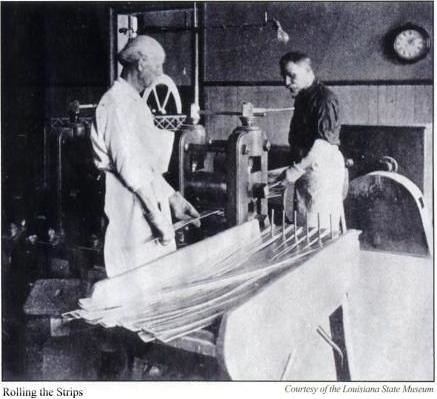
I'm really looking forward to the re-publication of this pamphlet now that I've started researching the post-Civil War activities of the New Orleans Mint. I've found a couple of reports from Mint officials that suggest that the New Orleans Mint used the same four coin presses for its entire life, so I'm hoping for some good pictures of them in the pamphlet.
BOOK REVIEW: UNITED STATES PATTERN COINS 2009 10TH EDITION BY J. HEWITT JUDD
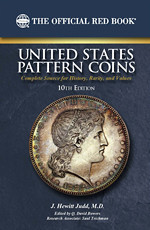 Obtaining information on pattern coins has certainly gotten easier with the new hardbound 2009 10th edition nited States Pattern Coins by J. Hewitt Judd, M.D. This "Official Red Book" was edited by Q. David Bowers with assistance from Research Associate Saul Teichman. This well-illustrated reference is 352 pages long and covers experimental pieces from 1792 to 2000. For the first time ever this J. Hewitt Judd classic text is illustrated in brilliant color.
Obtaining information on pattern coins has certainly gotten easier with the new hardbound 2009 10th edition nited States Pattern Coins by J. Hewitt Judd, M.D. This "Official Red Book" was edited by Q. David Bowers with assistance from Research Associate Saul Teichman. This well-illustrated reference is 352 pages long and covers experimental pieces from 1792 to 2000. For the first time ever this J. Hewitt Judd classic text is illustrated in brilliant color. Each design is shown along with a unique approach to understanding the pattern market. The grid gives the following: Judd Numbers, Metal used to strike the coin, Coin’s edge, Rarity, Number of times graded by ANACS, NGC and PCGS, Number of times sold at significant auctions since 1990, Auction house last sold, Date of the last sale, Selling price, Grade of the coin sold, and then prices you might expect to pay in three grade levels. Each line of the grid gives all the above information and each line is a different Judd number for that design. This concise grid allows the collector to compare all of the Judd numbers of that design based on the above characteristics.
Each design also has notes describing the issue as well as useful information needed to understand the pieces.
The section on die and hub trials and splashers is very comprehensive with much interesting information about each piece. Pieces not of mint origin are included in a special section so collectors can identify these pieces and learn something about them. The last section shows rarities and curiosities. Pictures and information on the Amazonian “Panorama” of 1872 are included in this section. Q. David Bowers, with help from other experts in the field, have once again brought to the numismatic hobby a “must buy” reference on America’s rarest coins, U. S. Patterns.
In summary, we feel this reference is a must for all collectors and dealers of pattern coins and those collectors who have a curiosity about numismatics in general. For information on purchasing this reference which costs 39.95 retail please contact: Whitman Books, LLC, 3103 Clairmont Road, Suite B, Atlanta, Georgia 30329, Call Center: 800-546-2995 or visit their web site at: www.whitmanbooks.com
One particularly interesting aspect of the book is the inclusion of images of die trial impressions on cardboard from the collection of the Library Company of Philadelphia (see Appendix A). I've said this before but it bears repeating - any serious student of U.S. numismatics MUST read this book. A familiarity and understanding of pattern issues is essential for understanding the history and evolution of U.S. coinage.
And if I were the next U.S. Mint Director, I think I would lobby Congress for changes to the laws to allow the Mint to again distribute and sell pattern coins. The greatest disappointment in the pattern book is not the fault of its authors - after 1885 the supply of patterns dried up, allowing only a scant few pages of listings of known modern patterns. The historical record of a century is nonexistent.
One recommendation I would have for future editions is to consider increasing the size of the book to allow for larger illustrations. A number of photos are reduced from actual size and to my aging eyes are difficult to see. I would prefer to have many of the images shown larger than actual size.
Congratulations to Dave, Saul and all the contributors, many of whom are E-Sylum contributors as well, including Mark Borckardt, Ken Bressett, Roger Burdette, David Cassel, John Dannreuther, George Fuld, Ron Guth, David Lange, Larry Lee, Dennis Loring, Joel Orosz, Andrew Pollack and David Tripp. -Editor
NEW BOOK: COINS: QUESTIONS AND ANSWERS FIFTH EDITION BY CLIFFORD MISHLER
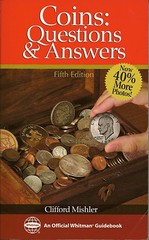 The fifth edition of Coins: Questions and Answers has been released by Whitman Publishing. This small volume packs a lot of information inside, and is a great place for beginning U.S. coin collectors. Originally put together to answer Frequently Asked Questions by readers of Krause coin publications, the book covers a wide range of topics in a brief, yet interesting and informative way.
The fifth edition of Coins: Questions and Answers has been released by Whitman Publishing. This small volume packs a lot of information inside, and is a great place for beginning U.S. coin collectors. Originally put together to answer Frequently Asked Questions by readers of Krause coin publications, the book covers a wide range of topics in a brief, yet interesting and informative way. I happened to have a copy of the third edition on my bookshelf, so I pulled it out for a look. The third edition was produced by Krause Publications. The page sizes and number of pages are different, but flipping through the two together I found many sections where the text matches word-for-word.
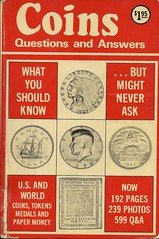
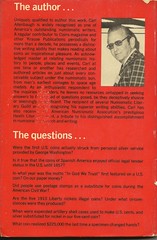
No surprise there, but I was curious about how the book came to be published by Whitman. I was also confused by the back cover of the third edition - it pictures Carl Allenbaugh and credits him as the author. So at what point did Whitman take over as publisher, and when did Mishler become the sole editor/author - after Allenbaugh's death?
In true E-Sylum fashion I went straight to the source and asked Cliff Mishler. He writes:
By the time the second edition rolled around, I believe we just indicated that it was the work of the Krause Publications editors, as Ed and Al were no longer in the mix. Again, I coordinated the project.
When it came time to generate the third edition, sometime in the early 80s as I recall, I commissioned the late Carl Allenbaugh to completely rewrite the materials.
Then, somewhere along the line I traded the title to Whitman in exchange for the Mexican Coins book by Ted Buttrey and Clyde Hubbard.
There were several printings of the fourth edition presented over the years, with me listed as author and a footnote: “Based on an Original Manuscript by Carl Allenbaugh.”
When the fifth edition was being worked up, I had requested that Whitman again incorporate on the title page an acknowledgment of the contributions that had been provided by Carl, but somewhere along the line my request got misplaced, and when I was reviewing the final pages I missed that fact.
THE BOOK BAZARRE
AMERICA'S OLDEST FREE LIBRARY MAY CLOSE
"We're on the chopping block," said Susan Borders, director of the library at 10th and Main streets, near the Southwest Philly border. "We thought we may have had four years left, but after going over our finances, we only have this year."
Founded by 29 Quaker townsmen, the library received its first shipment of 45 volumes from London in November 1743, with the assistance of botanist John Bartram.
"It's older than our country," said Raymond Trent, a longtime bibliographic assistant at the University of Pennsylvania Law School who has donated books, DVDs and other reference materials to Darby's library.
Some books from its original collection - including John Milton's Paradise Lost and Paradise Regained and Sir Walter Raleigh's The History of the World - are still displayed in the two-story brick building, built by Charles Bonsall in 1872 at a cost of $8,895.54. Others are at the Library Company of Philadelphia, founded by Benjamin Franklin in 1731 as a subscription library.
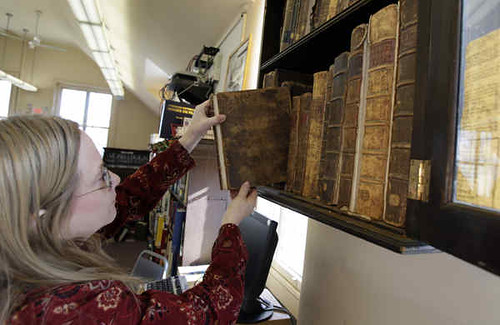
"If it does not get support now, it will not survive," Borders wrote in a summary to the Darby Library Company board at last week's meeting, when the possible closure was announced.
Tax-deductible contributions can be sent to the Darby Library Company, P.O. Box 164, Darby, PA 19023.
To read the complete article, see: Darby library faces the ax/ Oldest in U.S., it's in $ pinch (http://www.philly.com/dailynews/local/20090122_Darby_library
_faces_the_ax__Oldest_in_U_S___it_s_in___pinch.html)
THE ROYAL COLLECTION OF HANNOVER MAY BE SOLD
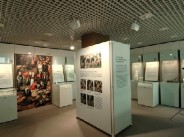 Nathan's unnamed French colleague wrote:
Nathan's unnamed French colleague wrote: Nathan wrote:
The sale of this important numismatic collection would be a great loss to numismatic scholarship. It should not be simply be divided up among bidders. I encourage all readers to send letters to those responsible for the decision to sell the collection and to the named German politicians. Dr. Lucia Travaini (Milan/Rome) has a page on her website, http://www.luciatravaini.it/ about the affair (click on 'Appello urgente per la collezione numismatica di Hannover,' which then takes you to a page in English with further links). You can also read her letter online.
To read the complete article, see: Disaster in Germany: The Royal Collection of Hannover for Sale!!! (http://coinarchaeology.blogspot.com/2009/01/disaster-in-germany-royal-collection-of.html)
RESEARCHING A GUIDE BOOK OF PEACE DOLLARS
Thanks to Mike Marotta for his comments concerning A Guide Book of Peace Dollars. His 1995 article was an important part of my research. As noted in the book’s introduction, background information was derived largely from my book Renaissance of American Coinage 1916-1921, and it is there that readers will find extensive source citations and a more expansive bibliography.
In researching the Peace dollar, I was fortunate to locate the mint’s original project file and de Francisci’s personal papers which included material not previously available. This permitted me to avoid second hand and speculative sources, while allowing the people and events surrounding the coin’s creation to tell their own story.
One minor comment concerning Farran Zerbe: other than his 1920 letter to the ANA convention, Mr. Zerbe played no role in design, modification or production of the Peace dollar.
As for a hard cover edition. That is a decision for Whitman Publishing LLC to make although it would be nice to have.
MORE ON THE ARMAND-DELILLE RABBIT MEDAL
You can learn the most interesting facts through numismatics. Last week Ed Snible asked if anyone could locate an image of a medal awarded to Paul Felix Armand-Delille, "a French professor who accidentally killed 98% of the rabbits in Europe during the 1950s." Top that, Elmer Fudd.Ever quick on the trigger, Gar Travis was the first to submit an image shortly after our issue was published last Sunday. Ron Haller-Williams also located this reference.
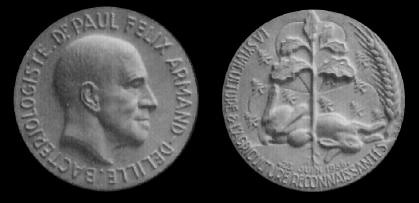
In 1952, at the age of 78, Delille
For more information, see: Myxomatosis in France (feuilleuse.free.fr/mixo.pdf)
ON THE NATURAL DRAW OF MONEY
Tim Shuck writes: The article about artist Michael Theise and his Monopoly board painting reminded me of an experience I had many
years ago. I was 'volunteered' to help teach a vacation bible school class of preschoolers. Not having been
around small children (this was before I was married and had children of my own), I was a bit nervous and, as it
turned out, naive about how children perceive the world.
The article about artist Michael Theise and his Monopoly board painting reminded me of an experience I had many
years ago. I was 'volunteered' to help teach a vacation bible school class of preschoolers. Not having been
around small children (this was before I was married and had children of my own), I was a bit nervous and, as it
turned out, naive about how children perceive the world. The story to be taught was about the money-changers in the temple, and I came up with the brilliant idea of making foil impressions of real coins and gluing them to the story board along with other scenery pictures. When my turn came to give the lesson, I pulled out the board and pandemonium ensued. All of the kids rushed forward to touch the money, which looked real enough to them. It took half the lesson time to get everyone back to his or her seat.
I suspect the only thing remembered was the 'money', as attractive to four and five year-olds as Theise's 'currency' apparently is to adults.
MORE ON THE SOCIETY OF BEARDED NUMISMATISTS
Pete Smith writes:John Regitko writes:

As for Jack Veffer and the S.O.B.s:
1. I was the sales manager for his book “My Two Cents Worth” as well as his accountant for Coiners Press. As a matter of fact, I still have the original artwork of the book, as well as the Coiners Press financial records. I also inherited his remainders of the book, which I gave away for club door draws, etc., so only have a few copies left.
2. I gave a few speeches over the years about the S.O.B. Numismatists and had articles published in various Canadian publications. I was invited by Bill Kamb in 2005 to speak at the Ohio State Numismatic Association Convention and chose “Putting the Fun back into the Hobby” as my main topic. One of the things I covered was the S.O.B.’s. I am attaching the summary of the speech I handed out to everyone at the banquet.
3. Also attached is a 3-page summary of the “Jack Veffer Collectibles” that I wrote about in the Ontario Numismatic Association and the Wooden Money bulletins.
4. When Jack went on vacation, I agreed to publish one of the bulletins. Instead of calling it “The Society of Bearded Numismastists, I removed all the hair (beards and top of the head) from his masthead and published “The Society of BALD Numismatists. Because those were the days before computers became popular, I will have to scan it into my computer soon.
5. If any of your readers wish copies of the two articles attached as well as other bulletins that Jack issued, have them contact me at coinman@look.ca and I will be pleased to e-mail them all the articles as I recreate them in my computer.
6. The copyright of his book and articles remain with Coiners Press, of which I am the remaining executive. I intend to reproduce both the book as well as all S.O.B. bulletins on my new website as soon as I have it up and running.

Sheldon S. Carroll, Grover Criswell, Doug Robins, Yasha Beresiner and Robert Willey were just some of the well-known members who sported beards.
For obvious reasons, there were no female members. Women were awarded Associate Membership...if sponsored by five regular members in good standing. Ingrid Smith, Ruth McQuade and Dora de Pedery- Hunt were just three of the well-known female associate members.
Associate Membership could be awarded to men without beards under one condition. An Associate S.O.B. shall always pick up the tab when having a social drink with an S.O.B. Some of the male Associate Members were Robert Aaron, Alex Munro, William McDonald, Al Bliman, Chuck Moore, John Dewyze, Albert Kasman, Ross Irwin, Guy Lestrade, Abe Rogozinski and John Regitko.
Every cent raised through bribes and other donations was donated to the J. Douglas Ferguson Memorial Foundation, a registered non-profit numismatic organization. Jack just kept paying the bills out of his own pocket. Printing and postage sure added up.
Then Jack got the idea of putting out a 32-page bulletin, complete with heavy cover, folded and stapled. He put a pile of his own money into its creation and distribution. Just as I attempted to publish articles in the ONA Numismatist when I was their editor dealing with numismatics of Ontario, so the S.O.B. Numismatist’s S.O.B.Servations published articles about bearded people. Their “People in the News” covered members with beards. Their numismatic articles were about banknotes that contained famous people that sported beards.
DO E-SYLUM READERS DESERVE A MEDAL?
Anyway, our discussion of Society of Bearded Numismatists medals led to my call for thoughts on a whimsical name for E-Sylum readers. -Editor
Jim Duncan of New Zealand writes:
Pete Smith writes:
HAS EARLY ARTWORK FOR THE MORGAN DOLLAR BEEN FOUND? OTHERS THINK NOT
Matt Hansen of Harrisburg, South Dakota writes:
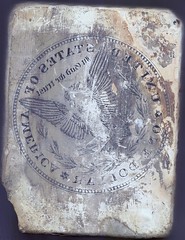 Regarding your query in the most recent E-Sylum about "HAS EARLY ARTWORK FOR THE MORGAN DOLLAR BEEN FOUND?", the object in question appears to be a lithographic printing stone. Lithographic stones were typically a very fine-grained limestone (often from Bavaria) onto which a reverse image of the subject to be printed would be transferred using a waxy ink. These were commonly used in the 1800s Additional information on the process of stone lithography can be found at: How Stone Lithography Works (www.howstuffworks.com/stone-lithography.htm)
Regarding your query in the most recent E-Sylum about "HAS EARLY ARTWORK FOR THE MORGAN DOLLAR BEEN FOUND?", the object in question appears to be a lithographic printing stone. Lithographic stones were typically a very fine-grained limestone (often from Bavaria) onto which a reverse image of the subject to be printed would be transferred using a waxy ink. These were commonly used in the 1800s Additional information on the process of stone lithography can be found at: How Stone Lithography Works (www.howstuffworks.com/stone-lithography.htm)My guess is that the piece was created by a printer at newspaper or magazine or order to reproduce an image of the coin. This printing technique was in widespread use at the time the Morgan dollars first came out in 1878, so maybe it was someone wishing to illustrate the new coin design in some publication. We'll probably never know for sure.
George Cuhaj writes:
Tom DeLorey agrees. He writes:
Bill Eckberg writes:
I have never actually seen how one of these engraved stones was used, but I presume it was printed like an etching or engraving on a metal plate in that ink was squeezed into the lines and transferred to wet paper, much the way our paper money is still printed.
Red Book editor Ken Bressett writes:
THE BOOK BAZARRE
THE FIRST ENCAPSULATED U.S. COIN: 1840-O HALF DIME IN GLASS
The glass piece is 3- ¼” tall and 1-5/8” in diameter, except at the base where it expands to 1-7/8” in diameter.
Of greatest interest to a half dime collector, of course, is the 1840-O No Drapery V4 half dime contained within the knop.
It appears to be in borderline mint state condition, or what I would grade AU-58, with only the very slightest rub evident on the highest points of the design (Miss Liberty’s beasts and thigh).
There are no marks, dings or other distractions of any description, and the surfaces exhibit what must be considered truly “original” color.
The coin has been encapsulated in a totally sealed environment for nearly 170 years, subjected only to less than four cubic centimeters of air.
This is a fascinating piece of history, decidedly numismatically related, which provides us some insight into what ‘original’ surfaces must have looked like.
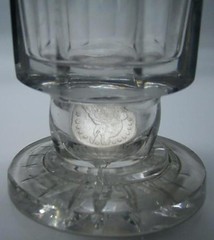

NUMISMATIC NEWSPAPERS AND THE U.S. POST OFFICE
Ginger Rapsus writes:I do as much online as I can, but the issues are difficult to read. I tried to get Numismatist online, and I got the odd-numbered pages only. I probably did something wrong! Today the local Post Office called and told me the problem is not with them - they said I should tell Coin World to mail the papers on time. According to Coin World, the paper is mailed every Monday. The nice man from the Post Office said, oh, they can say one thing and do another!
I've had delivery problems of my own lately. For security I don't like to have coin newspapers mailed to my home. Instead, I get them at my office. The company I work for had two offices in the building I work in. One of the offices moved 20 miles away and mail was forwarded. The other office (where I work) never had mail delivered to it directly, and the post office doesn't seem to know we exist. For about a month I got none of my numismatic newspapers (Coin World, Numismatic News, Bank Note Reporter) because third-class mail doesn't get forwarded. I called to change my address to the other office, but now my issues land twenty miles away and I only occasionally get over there to pick them up.
I guess I could try the online route, too, but I agree with Ginger that the electronic versions are less convenient, particularly if one like to peruse a paper version at lunchtime. -Editor
2,000 YEAR OLD HOARD OF GOLD COINS FOUND
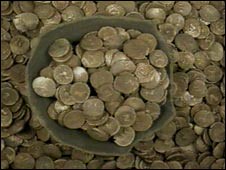 A hoard of 825 coins that belonged to a member of the Iceni tribe before Boudicca led them against the Romans has been found in a Suffolk field.
A hoard of 825 coins that belonged to a member of the Iceni tribe before Boudicca led them against the Romans has been found in a Suffolk field. An anonymous metal detector fan found the gold coins valued at up to £500,000 near the village of Dallinghoo.
Landowner Cliff Green said he was stunned to think the last time they had been seen before they were spread out on his table was 2,000 years ago.
Suffolk's county archaeology department dated the coins.
To read the complete article, see: Iceni coins worth £500,000 found (news.bbc.co.uk/2/hi/uk_news/england/suffolk/7838892.stm)
HMS VICTORY WRECK FOUND IN BRITISH CHANNEL; WAS HAULING FOUR TONS OF GOLD COINS
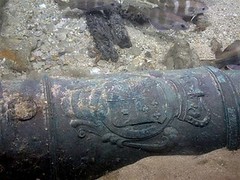 Deep-sea explorers who found $500 million in sunken treasure two years ago say they have discovered another prized shipwreck: A legendary British man-of-war that sank in the English Channel 264 years ago.
Deep-sea explorers who found $500 million in sunken treasure two years ago say they have discovered another prized shipwreck: A legendary British man-of-war that sank in the English Channel 264 years ago.The wreckage of the HMS Victory, found below about 330 feet of water, may carry an even bigger jackpot. Research indicates the ship was carrying 4 tons of gold coins when it sank in storm, said Greg Stemm, co-founder of Odyssey Marine Exploration, ahead of a Monday news conference in London.
So far, two brass cannons have been recovered from the wreck, Stemm said. The Florida-based company said it is negotiating with the British government over collaborating on the project.
"This is a big one, just because of the history," Stemm said. "Very rarely do you solve an age-old mystery like this."
Thirty-one brass cannons and other evidence on the wreck allowed definitive identification of the HMS Victory, 175-foot sailing ship that was separated from its fleet and sank in the English Channel on Oct. 4, 1744, with at least 900 men aboard, the company said. The ship was the largest and, with 110 brass cannons, the most heavily armed vessel of its day. It was the inspiration for the HMS Victory famously commanded by Adm. Horatio Nelson decades later.
To read the complete article, see: Wreck of renowned British warship found in Channel (http://news.yahoo.com/s/ap/20090201/ap_on_bi_ge/shipwreck_discovery)
Arthur Shippee forwarded another news item about Odyssey Marine. Finding and recovering treasure is the easy part - defending your haul in court is a bigger hassle, I'm sure.
To read the complete article, see: Peru Pushes Claim on $500M Shipwreck Treasure
WHERE TO OBTAIN ZIMBABWE HYPERINFLATION BANKNOTES
Last week Granvyl Hulse asked: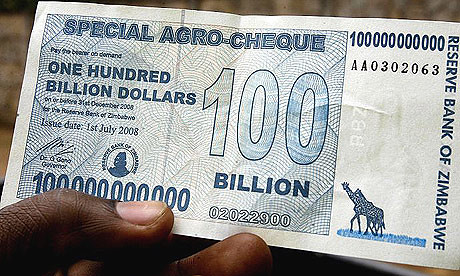
Above is an image of the $100 Billion note. Kerry Rogers reports that this dealer has examples of the $100 Trillion note in stock for $100, including shipping: www.worldcurrency.com
One E-Sylum reader writes:
Jon Radel writes:
In the January 25 E-Sylum several questions came up about the current banknotes of Zimbabwe. Between the chaos in Zimbabwe and the general reticence by central banks and their printers to discuss contractual arrangements and technical details, there are many details which are uncertain, however, some details have been documented in the press and more have been subject to what appears to be informed speculation among observers in Harare.
What is clear is that the Reserve Bank of Zimbabwe has a wholly owned subsidiary, Fidelity Printing and Refining Limited. As of July 1, 2008, as Giesecke and Devrient GmbH (G&D) pulled out of Zimbabwe, Newsweek [1] reported that G&D was printing about half the currency and supplying the security paper for the other half, presumably all used at Fidelity Printing, which was at that point running its equipment around the clock.
I've seen little hint as to what equipment Fidelity Printing is using for the locally produced notes. In late July 2008 there were press reports out of South Africa and elsewhere that Jura JSP, an Austrian company, was supplying the Reserve Bank with licensed software for the design of banknotes. [2] The presses themselves appear to be German made, or at least that was the source of the spare parts the staff feared would no longer be available as of July 2008. [3]
The quality of the paper used for all notes printed after the G&D paper ran out has been of lower quality, lacking watermarks and other security devices. To what extent this represents a lack of capability by the new supplier(s) and to what extent the Reserve Bank has simply decided to save money is unknown to me. Back in July 2008 the Reserve Bank announced that they were going to use a local paper supplier, though doubts were expressed given that they were already having trouble meeting current orders [3]. Since then, I've heard speculation that the paper is being imported from China, though my correspondent in Harare was unable to give me leads on documentation on that.
Sometime soon, after more of the latest notes that are supposedly in transit to me actually arrive, I hope to analyze the actual characteristics of the notes. I'll offer my results to the editor. Meanwhile, one of the best sources for an organized listing of all the banknotes is the Wikipedia page. [4]
As for where to buy the $100 trillion notes? That's a bit tricky. There are several sellers on eBay who will happily take your money (quite a lot of it, as a matter of fact, you can purchase a set of the 4 trillion dollar notes for USD 110 right now, and I've heard reports of prices as high as GBP 300), but it's unclear that they'll ever be able to deliver. While the $10, 20, 50, and 100 trillion notes have all been announced, only the $10 trillion was actually released on January 16. On January 29, I confirmed with my source in Harare that the 4 banks he deals with had been given no information on the release of the other 3 notes. Given that on January 29 controls on use of foreign currency were removed [5], it is quite possible that the local currency will completely collapse before more notes are issued.
That said, eBay is the only source I've found for the latest notes. The normal channels for world banknotes really don't move fast enough; one of my favorite "conventional" suppliers is just now able to offer the last of the 2nd dollar notes, and that was many, many zeros ago.
As a parting thought, this quote from Dr. Gono that the Reserve Bank has been running on their home page for some time now may help clarify everything: "I am pleased to report that the invisible forces of destruction have been unmasked marking a turning point chapter when the fraudulent and speculative winds are cast into the inferno of extinction."
Anybody who knows more, do please share!
[1] http://www.newsweek.com/id/144387/output/print
[2] http://www.monstersandcritics.com/news/africa/news/article_1419212.php
[3] http://articles.latimes.com/2008/jul/14/world/fg-money14
[4] http://en.wikipedia.org/wiki/Zimbabwe_banknotes
[5] http://www.washingtonpost.com/wp-dyn/content/article/2009/01/29/AR2009012900855.html
Don Cleveland forwarded an electronic newsletter from Steve Milner of the International Bank Note Society (IBNS). The Rhodesia—Zimbabwe Banknote Newsletter has just been launched - the issue is Number 1, January 2009. In it Steve writes:
The banknote collecting “bug” hit me over 30 years ago when I lived in Rhodesia and took another quantum leap with the advent of the internet in the mid-nineties. Since then I have built up a reasonable collection and database of all the issues, date and signature varieties and so on.
I have started this newsletter after I thought that it would be a good idea to share knowledge about the banknotes and paper currency of this troubled country. I am being asked questions by collectors from all over the world on a regular basis and a newsletter would be a good medium to share that knowledge.
Hopefully the newsletter will become an educational tool for all of us to share.
For more information, or to request a copy, contact Steve Milner at durham_111@yahoo.com.au
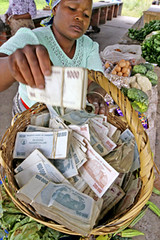 Zimbabweans will be allowed to conduct business in other currencies, alongside the Zimbabwe dollar, in an effort to stem the country's runaway inflation.
Zimbabweans will be allowed to conduct business in other currencies, alongside the Zimbabwe dollar, in an effort to stem the country's runaway inflation. The announcement was made by acting Finance Minister Patrick Chinamasa.
BBC southern Africa correspondent Peter Biles says the Zimbabwean dollar has become a laughing stock. A Z$100 trillion note was recently introduced.
Until now only licensed businesses could accept foreign currencies, although it was common practice.
"In line with the prevailing practices by the general public, [the] government is therefore allowing the use of multiple foreign currencies for business transactions alongside the Zimbabwean dollar," he said.
The country is in the grip of world-record hyperinflation which has left the Zimbabwean dollar virtually worthless - 231,000,000% in July 2008, the most recent figure released.
Teachers, doctors and civil servants have gone on strike complaining that their salaries - which equal trillions of Zimbabwean dollars - are not even enough to catch the bus to work each day.
A Harare resident said even street vendors were refusing to accept Zimbabwean notes.
Last year, the Central Bank was forced to slash 10 zeros from the local unit in an effort to make the currency more manageable.
Correspondents say that although the local currency will still be printed, all prices will be set in US dollars, making the Zimbabwe dollar irrelevant.
To read the complete article, see: Zimbabwe abandons its currency (news.bbc.co.uk/2/hi/africa/7859033.stm)
ANOTHER CONCORD REVOLUTION: A BUSINESS BANS THE CENT
“The beauty of it is that it starts here, in Concord, Massachusetts,” Lewis said. “Concord is the birthplace of civil disobedience, the place where Thoreau went to jail for protesting the Mexican War.”
The plan will be put into action on Thursday, Feb. 12, the 200th birthday of Abraham Lincoln, whose face is on the coin the bakers and blogger seek to eliminate.
To mark the occasion, Lewis will drop pennies on the sidewalk outside the bakery, ostensibly asking police to issue him a citation for littering, which he says would prove that federal law requires businesses to accept litter as legal tender.
Inside the store, cashiers will round down cash transactions to the nearest nickel so as not to have to pass out pennies for change. For instance, an $11.04 bill gets reduced to $11, while a check for $8.99 would become $8.95. Additionally, all pennies given as payment, the cashiers will toss into a jar designated for a charity.
“Everybody hates pennies,” said Teacakes co-owner Judy Fersch. “This will save time. It will save lugging — I end up being the one going to the bank [to pick up pennies] half the time. And it’s ridiculous. All we have to do is find a charity that will accept pennies.”
To read the complete article, see: For Teacakes, pennies make no cents (http://www.wickedlocal.com/concord/news/
x1992964198/For-Teacakes-pennies-make-no-cents)
CONCORD CENT REVOLUTION ADVOCATES SUGGEST MAKING A LINCOLN STATUE OF THE COINS
They don't have to bring rolls of pennies to their shops from the bank. They don't have to put them in their cash registers. And they don't have to hand them out for many transactions. It saves time they say.
“Being right across from the train station, we have long lines before trains leave and pennies make it worse,” said one merchant. “Further, there is a lot of lugging them from the bank, dropping them, not being able to reconcile register receipts and so on."
They blame the zinc lobby. "Mining zinc" the merchant adds. "is an environmental nightmare, and it costs the government more to make pennies than they are worth. Finally, [the Treasury has] minted thousands for every man, woman and child. Where do they all go? If they were truly worth anything they wouldn’t end up in coffee cans, vacuum cleaners or sofas. It is simply a tax, which raises no revenue.”
"Concord is ... the birthplace of civil disobedience, where Henry David Thoreau went to jail for refusing to pay poll taxes to support the Mexican War," notes the writer in the Concord News. Bill Griffin, Of Sally Anne’s Bakery in Concord Center, said he would like to have his register reprogrammed to round all prices including tax, to avoid handling pennies. “Until that happens, I still have to handle these worthless coins,” he said. “Let’s start a revolution right here in Concord to get rid of them altogether.”
The Concord News further reports: Regular West Concord shopper and Concord resident Christal Bjork reflects the sentiment of most other customers when she said, “They’re wasteful and it would be much easier not to have them. I think this is a great idea.”
This act of civil disobedience was conceived by www.ThinkOOB.com, the Think-Out-of-the-Box Web site which bills itself as “America’s Marketplace of Ideas,” as a way to draw attention to its idea for phasing out pennies, as well as to its other ideas and to its million-dollar prize for the first idea originated on the ThinkOOB site to become law.
Early this week, the protest began to spread to Concord Center as well, with Anderson’s, Sally Anne’s, The Concord Flower Shop, and Country Kitchen also on board.
“This is where Concord’s second revolution starts and ultimately the site should be commemorated with a statue of Lincoln, who himself would approve of our emancipation from the tyranny of the zinc lobby,” said Lewis. “Since this is Concord, I’d like to see an Emersonian quatrain inscribed on the statue as follows: “To the rude lobbyists who corrupted our good Congressmen to support their zinc here the embattled merchants stood and said: “We think your pennies stink.”
IS U.K. COIN GLUT AN UNINTENDED CONSEQUENCE OF A TAX CHANGE?
Dick Johnson writes:It would appear that some consumers' pockets are being worn thin by the sheer weight of coins that they now have to carry around with them.
By reducing the rate from 17.5 per cent to 15 per cent in his November Pre-Budget Report, the Chancellor caused retailers to reprice their goods, from round figures to oddly-priced sums. So a £10 jumper is now £9.79.
A £4.99 item, which would previously have called for just one penny in change from a £5 note, will now cost £4.88, increasing the demand for change.
Egin Eshref, a leading London dry cleaner who owns the Spots chain, said that he had noticed far more customers coming into his outlets asking for their half-pockets – the small coin pockets on many trousers – to be mended.
"It's very noticeable. We haven't been mending these pockets for years, but there's been a real pick up in people asking for them to be replaced or strengthened," he said.
He added that in recent years his company had almost stopped doing this type of repair because hardly any of his customers used the half-pocket, thanks to the increasing use of debit cards.
Many retailers have complained about the logistics of the new VAT rate, which has not only seen them print new price labels, but also caused them to stock more small coins in their tills.
Simon Hargraves, commercial director at Pret a Manger sandwich chain, said: "We've definitely had to stock our tills differently. It's been very confusing," he said.
A spokesman for the Royal Mint said that there were no more coins in circulation since the VAT change, but said they were "keeping an eye on the situation".
To read the complete article, see:
(www.telegraph.co.uk/finance/financetopics/financialcrisis
/4337894/Coin-glut-following-VAT-change-damaging-our-pockets-say-dry-cleaners.html)
OHIO CREDIT UNION PROMOTION GENERATES AN AVALANCHE OF COIN DEPOSITS
 I wrote last Sunday that the coming week was to be the Akron Saves campaign's Roll Your Change Week.
I wrote last Sunday that the coming week was to be the Akron Saves campaign's Roll Your Change Week.As a part of that, I pointed out that the folks at the Towpath Credit Union were part of the community effort and were offering a 10 percent match to anyone who would deposit the money into an account — up to a maximum $100 bonus.
They had no idea what was about to hit them.
Towpath officials called Wednesday to say they had already opened 50 new accounts at their two offices and estimated they'd collect $100,000 in change by the end of the week.
They shattered that prediction.
By the close of business Friday — a holiday-shortened week — they had accepted 833 deposits, including into 188 new accounts, by collecting $266,000 in coins.
Linda Lance of Akron was one of those depositors — and a big one at that.
She said her husband Wes had been saving change for probably more than 20 years. He'd fill coffee cans and stash them around the house. She'd yell at him to move his cans.
''I saw the story in the paper and thought, 'This is the perfect time.' '' she said.
So he bought her a red wagon, built a ramp and loaded everything into her SUV before he headed off to work.
It took her two wagon trips into Towpath's Akron branch.
Her husband thought perhaps he had $1,000 in change.
When the teller told Lance she was approaching $2,000, the anticipation began to grow.
Others marveled as the count continued.
''Most of them had one jar,'' Lance said. One woman decided to stay and watch. ''It was kind of like being in Vegas and playing the slot machine and having everyone watch you. It really was an adventure.''
Her final count: $4,120.18.
To read the complete article, see: Savers ring up bonanza with coins (http://www.ohio.com/business/38289474.html)
OBAMA HUCKSTERS STICKING SUCKERS WITH STICKERS
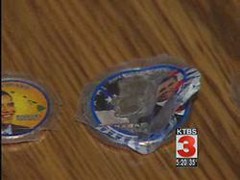
Her collection of presidential coins is impressive and something Tanya Thomas takes great pride in. Her latest purchase, though, has left her feeling short-changed.
She paid The National Collectors' Mint a pretty penny for four Barack Obama coins, But she thought $75 was a small price to pay to add the 44th president to her collection. That is until her daughter brought them home after show and tell at school.
"The whole front comes off. It's just a sticker stuck on top of a regular quarter or regular Kennedy half dollar. It's just a Barack Obama sticker stuck on top", says Thomas.
While Thomas wasn't familiar with the National Collectors Mint out of New York, the Better Business Bureau is.
The coin dealer has an unsatisfactory record with the BBB, because there's been a pattern of complaints and the business has not taken action to correct them.
-Editor
To read the complete article, see: Obama coin con short-changes collector (http://www.ktbs.com/news/Obama-coin-con-short-changes-collector--24588/#)
GHOST WHISPERER HELPS DEAD NUMISMATIST FIND PEACE
Tim Shuck writes:After Melinda found the coin and returned it to the rightful heir, the departed numismatist's spirit was free to move on.
I found it interesting that this particular coin was part of the story. It's well-known to collectors but probably not so with the general public; this makes me think there must be a collector on the writing staff.
FEATURED WEB PAGE: IRISH MINING TOKENS
This week's Featured Web Page is on Irish mining company tokens.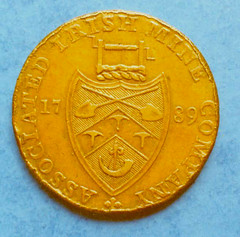
www.mining-memorabilia.co.uk/AIMC.htm
